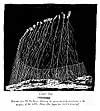I began doing comparative drawings of subjects Imagined, Observed and Remembered in 1977 in New York City, pursuing a line of enquiry which grew out of my first commissions as an illustrator and my struggle to evolve a style suitable for that genre. At work I was often required to depict things which I could not, without recourse to a model, render ‘realistically’, but for which I could usually invent recognizable hieroglyphs (as a cartoon is a hieroglyph) by basing these on an eidetic approximation of the particular item which I could “see” with that undissectable organ, the “mind’s eye.” In my immaturity I sometimes experienced a kind of vertigo when drawing, for a client, things purely as I imagined or remembered them to be. Would a picture of the idiosyncratic eidolon or phantom in my imagination be legible to the public as a sign for the thing intended? I doubted it. Often I destroyed the unity of my illustrations by populating, for instance, a stylized cartoon with items (the ‘props’ of the scene) which I’d copied in an academic manner from life or from photographs in my compulsion to ‘get them right’. Primarily as therapy, therefore, I began drawing sundry items thrice – first as I imagined them to be, then as I actually observed them to be, and lastly, after a suitable interval, as I remembered them to have been. I accorded no less a degree of ‘reality’ to the item as it appeared to my imagination or memory than to the item as it appeared to what Blake called the ‘vegetative organs’ of sight.
The subjects of the drawings (see list at left and below) were Observed as illustrations in Everyman’s Encyclopaedia, the 1931-32 edition. As they were completed, the Imagined and Observed drawings were covered with opaque masks and the pages put aside. The Remembered drawings were done from four to eight months later.
Should one wish to make an empirical study of the workings of one’s own mind, one might find that consciousness is so structured that it cannot objectively “spy” on itself, undetected by itself, as it discharges its routine functions – (this is the sublime “uncertainty principle” at the heart of Phenomenology which pervades it with a bitter ‘Pataphysical bouquet). Any attempt to examine hypnagogic or other mental images (except, perhaps, phosphenes*) is practically scuttled by a similar conundrum: we cannot study the image we are “seeing” in the mind, because to do so would demand “that at a given moment we should be able to stop producing [the image], in order to verify the result. … This cannot happen in imaginative consciousness.” (Sartre, The Psychology of Imagination). Thus one can only attempt to describe what such an image was “like”. Painting and drawing mental images confirms that their nature is less of the order of visual data and more that of abstract knowledge. Before drawing the LIVER Remembered, for instance, I do not scan my memory of the LIVER Observed in a manner analogous to visual exploration of actual terrain. Rather, I know it, the idea of it, which I then translate into visual terms. And this idea will naturally have lost detail, (it having been months since I drew the LIVER Observed) – so that when I come to draw a part that I suspect should be there, I often experience a local amnesia – I literally “draw a blank” – the Remembered drawings are overgrown with these like spots of mould.
Painting and drawing it is an attempt to “verify” the mental image, (admittedly it is not even approximately “scientific” verification), by comparing the image evolving on paper with the construct I have “in mind.” I seek to create on paper an equivalent, though necessarily different, construct. One which will give some indication of what the original was “like”.
“If all things became smoke, perception would be by the nostrils.”
Fragment – Heraklitos
It was while drawing teeth (Figures A and B) that I realized the following: unless one has never seen the thing one is attempting to draw, it is not properly Imagined, it is Remembered, albeit from unaided Memory. To Imagine some more or less familiar thing requires a creative engagement with it, a vision which transforms it and “makes it new”. How might I dream of a jaw of teeth? I answered this question with Figure C, a personal vision Imagined with the minimum of Remembered content.*
PB
* Let me qualify that. There is a much wider range of Remembered content in Figure C than in Figure B. But it is not restricted to “realistic” information about teeth. By playfully combining elements drawn from other domains a metaphor is created which invites the viewer to experience the idea of “teeth” in a new way.


